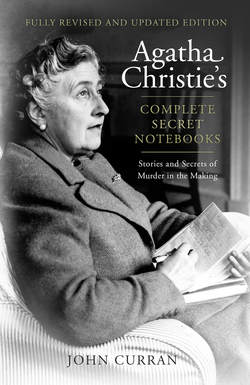Читать книгу Agatha Christie’s Complete Secret Notebooks - Агата Кристи, Agatha Christie, Detection Club The - Страница 60
The detective
ОглавлениеThe figure of the detective occupied both writers: Van Dine 4 and Knox 7 are identical, although Van Dine added further embellishments in Rules 6 and 9. Some of Christie’s greatest triumphs involve these Rules; she has joyously shattered all of them.
Van Dine 4. The detective himself, or one of the official investigators, should never turn out to be the criminal.
Knox 7. The detective must not himself commit the crime.
From the very beginning of the detective novel the unmasking of the official investigator was considered a valid ploy. The Mystery of the Yellow Room (1907) by Gaston Leroux, creator of The Phantom of the Opera, is credited in An Autobiography as being one of the two detective novels that Christie had enjoyed before embarking on The Mysterious Affair at Styles. It features one of the earliest examples of the criminal investigator, and in The Clocks, Poirot is unstinting in his praise for this groundbreaking novel. Some of Christie’s most deftly plotted books featured this ploy. Hercule Poirot’s Christmas was chosen by Robert Barnard, in his Agatha Christie: A Talent to Deceive (1980), as one of the three best novels of Dame Agatha’s career, and indeed it is a classic Golden Age detective story: a snowbound country mansion, a murder, a group of suspects, a killer and a solution, breathtaking in its daring. An early foreshadowing of this ploy can also be found in ‘The Man in the Mist’ in Partners in Crime.
The Mousetrap, in both its stage and novella versions, and its earlier incarnation as the radio play Three Blind Mice, all unmask the investigator as the villain. Sergeant Trotter arrives like a deus ex machina in Monkswell Manor and is accepted unquestioningly both by its snowbound inhabitants and by the audience, although he is an imposter and not an actual policeman. In the late 1940s and early 1950s the policeman, like the village doctor, was perceived as uncorrupted and incorruptible, although modern audiences are more likely to spot this type of villain than their more innocent counterparts of an earlier age.
In Curtain: Poirot’s Last Case, Agatha Christie played the last and greatest trick of all on her readers; and they admired her all the more for it. The ultimate sleight of hand from the supreme prestidigitator in the crime-writing pantheon, who but Agatha Christie would have thought of, and then carried out, this almost sacrilegious trick? After a half century of partnership, she unmasks Poirot as the killer. Certainly the book is contrived (which detective story is not?), but only the most churlish of readers would complain after such a dazzling culmination of two careers.
Van Dine 6. The detective novel must have a detective in it.
This is a perfectly reasonable Rule. But Agatha Christie made a career out of breaking the Rules, reasonable or otherwise, and she managed to demolish this one also. The most famous and best-selling crime novel of all time, And Then There Were None, has no detective, although, arguably, every character in the book is Victim, Murderer and Detective …; Death Comes as the End is also an example of a detectiveless detective novel. Its setting of Ancient Egypt 4,000 years ago does, however pre-date the Rules by some time.
Van Dine 9. There must be but one detective.
In the sense that Hercule Poirot and Miss Marple never meet between the covers of any of her books Agatha Christie abided by this Rule, but in many novels they work in close collaboration with the official investigators. And other titles feature an unofficial coming-together of, effectively, suspects in order to solve the crime. Three Act Tragedy, Death in the Clouds and The ABC Murders find Poirot working alongside some of those under suspicion in order to arrive at the truth. And in all three cases one of his group of collaborators is unmasked in the last chapter. Coincidentally or otherwise, these novels were all published in the same 12-month period between January 1935 and January 1936.
